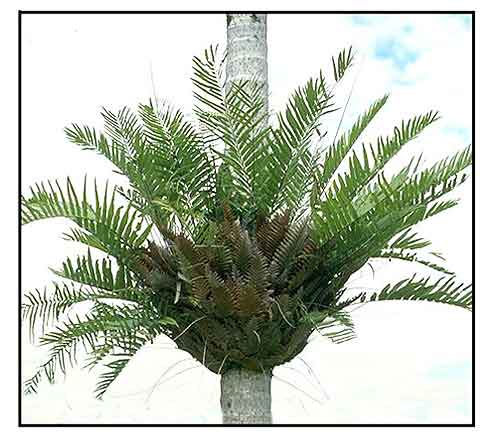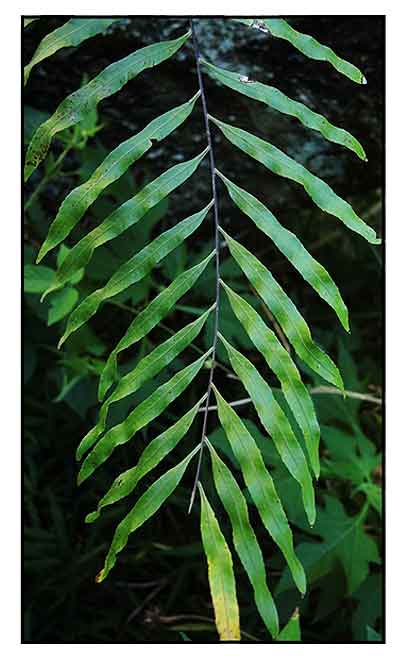
Family • Polypodiaceae
Pinog yupar
Drynaria rigidula (Sw.) Bedd.
BASKET FERN
Ying ye hu jue
| Scientific names | Common names |
| Aglaomorpha rigidula (Sw.) Hovenkamp & S.Linds. | Pinog yupar (Luzon) |
| Drynaria baudouinii E.Fourn. | Basket fern (Engl.) |
| Drynaria diversifolia J.Sm. | Rock fern (Engl.) |
| Drynaria gaudichaudii Bory | Shield fern (Engl.) |
| Drynaria glaucistipes J.Sm. | |
| Drynaria pinnata Fee | |
| Drynaria rigidula (Sw.) Bedd. | |
| Drynaria rigidula f. cristata (F.M.Bailey) Domin | |
| Drynaria rigidula var. vidgenii (F.M.Bailey) Domin | |
| Drynaria rigidula var. whitei (Bailey) F.Ballard | |
| Goniophlebium rigidulum T.Moore | |
| Polypodium baudouinii Baker | |
| Polypodium cuspidatum Moritz | |
| Polypodium diversifolium R.Br. | |
| Polypodium gaudichaudii Bory | |
| Polypodium glaucistipes Wall. | |
| Polypodium irioides f. cristatum (F.M.Bailey) F.M.Bailey | |
| Polypodium punctatum f. cristatum (Bailey) Domin | |
| Polypodium rigidulum Sw. | |
| Polypodium rigidulum var. cristatum F.M.Bailey | |
| Polypodium rigidulum var. diversipinnae F.M.Bailey | |
| Polypodium rigidulum var. vidgenii F.M.Bailey | |
| Polypodium rigidulum var. whitei F.M.Bailey | |
| Polypodium simplex Burm.f. | |
| Polypodium speciosum Blume | |
| Drynaria rigidula (Sw.) Bedd. is an accepted species. KEW: Plants of the World Online | |
| Among the Drynaria species, there is a confusing sharing of common names: basket fern, oak-leaf fern, bird's nest fern. | |
| Other vernacular names |
| INDONESIA: Paku kayakas, Simbar layangan, Pasilan kelapa. |
| NEW GUINEA: Poto, Tjekee. |
| THAILAND Kra prok lek, Kuut tang, Kuut mai. |
Botany
Distribution Constituents Properties Studies Availability |
April 2023
![]()
 |
| PHOTOS / ILLUSTRATIONS |
| IMAGE SOURCE: Photograph: Drynaria rigidula - growing on a palm stem / © M Fagg / click on image to go to source page / Australian National Botanic Gardens |
| OTHER IMAGE SOURCE: Photograph: Drynaria rigidula / © Michael Kesi / Non-commercial use / CC BY-NC Creative Commons Attritubtion NonCommercial License / click on image to go to source page / BioLib.cz |
OTHER IMAGE SOURCE: Photo: Scadoxus multiflorus / image modified / © World of Succulents / click on image to go to source page / World of Succulents |
| OTHER IMAGE SOURCE: Photo: Scadoxus multiflorus berries / Maja Dumat / CC by 2.0 / click on image to go to source page / North Carolina EXTENSION GARDENER Plant Toolbox |
| IMAGE SOURCE: Hedyotis costata / Subject Database of China Plant <http://www.naturemuseum.net/album/ShowPhoto.aspx?photoid=2671c974-77ca-44f9-b304-0f16660a06f7> Helixcn |
| OTHER IMAGE SOURCE: /Gliricidia sepium (Jacq.) Kunth ex Walp. - quickstick GLSE2 / Steve Hurst @ USDA-NRCS PLANTS Database / USDA |
| IMAGE SOURCE: / Photos (2) / Pterocaulon redolens (Willd.) F.-Vill. / © Collected by www.plant.ac.cn / ZHIWUTONG / CLICK ON IMAGE TO GO TO SOURCE PAGE |
| IMAGE SOURCE: / Line drawing / Pterocaulon redolens (Willd.) F.-Vill. / © Collected by www.plant.ac.cn / ZHIWUTONG / CLICK ON IMAGE TO GO TO SOURCE PAGE |
| OTHER IMAGE SOURCE: / Photo / Rutaceae : Lunasia amara det. John Rey Callado / Leaf / Copyright © 2012 by P.B. Pelser & J.F. Barcelona (contact: [email protected]) [ref. DOL52015] / Non-Commercial Use / Phytoimages.siu.edu |
| OTHER IMAGE SOURCE: Photo : Grewia bilamellata / Leaf / Copyright © 2015 by P B Pelser & J F Barcelona (contact: [email protected]) [ref. DOL101327] / Non-Commercial Use / Phytoimages.siu.edu |
| OTHER IMAGE SOURCE: / Flower close-up / dracobotanicus -- Wayne Dumbleton / Creative Commons Attribution / flickr / Click on graphic to see original image / flickr / |
| OTHER IMAGE SOURCE: / Illustration / Cissampelos pareira L. [5809-247450-161657] / Indian medicinal plants, vol. 1: t. 42 / PlantIllustrations.org |
| flickr / |
| Pacific Island Ecosystems at Risk (PIER) |
| Photos ©Godofredo Stuart / StuartXchange |
| Content © Godofredo Stuart / StuartXchange |
| Content / Photos © Godofredo Stuart / StuartXchange |
| Photos © Godofredo Stuart / StuartXchange |
Additional
Sources and Suggested Readings |
α•(5) |
DOI: It is not uncommon for links on studies/sources to change. Copying and pasting the information on the search window or using the DOI (if available) will often redirect to the new link page. (Citing and Using a (DOI) Digital Object Identifier) |
PHOTOS / ILLUSTRATIONS |
| List of Understudied Philippine Medicinal Plants |
α•(5) |
 |

 Gen info
Gen info Rhizome shortly creeping, 1-2 cm in diam.; scales brown to dark brown, with a lighter margin, spreading, peltate, 5-13 × 0.5-1.5 mm, margin ciliate, apex acute to acuminate; fronds dimorphic, rachises persistent; basal fronds 10-30 × 5-15 cm, lobed from 1/3-4/5, margin irregularly and finely denticulate; foliage fronds stalked, stipe up to 40 cm, not winged, with 2 rows of nectaries; lamina pinnate, 25-100(-200) × 12-50 cm, apex aborted; pinnae articulate to rachis, all equally long or smaller toward apex, 8-25(-30) × 0.5-1.5 cm, base narrowly cuneate, margin crenate to serrate, apex obtuse to acuminate, free veinlets simple or absent, hydathodes absent. Sori in 1 row between costa and margin, costal, single between veins, orbicular, sunken. Spores with short, blunt spines and globules. (
Rhizome shortly creeping, 1-2 cm in diam.; scales brown to dark brown, with a lighter margin, spreading, peltate, 5-13 × 0.5-1.5 mm, margin ciliate, apex acute to acuminate; fronds dimorphic, rachises persistent; basal fronds 10-30 × 5-15 cm, lobed from 1/3-4/5, margin irregularly and finely denticulate; foliage fronds stalked, stipe up to 40 cm, not winged, with 2 rows of nectaries; lamina pinnate, 25-100(-200) × 12-50 cm, apex aborted; pinnae articulate to rachis, all equally long or smaller toward apex, 8-25(-30) × 0.5-1.5 cm, base narrowly cuneate, margin crenate to serrate, apex obtuse to acuminate, free veinlets simple or absent, hydathodes absent. Sori in 1 row between costa and margin, costal, single between veins, orbicular, sunken. Spores with short, blunt spines and globules. (